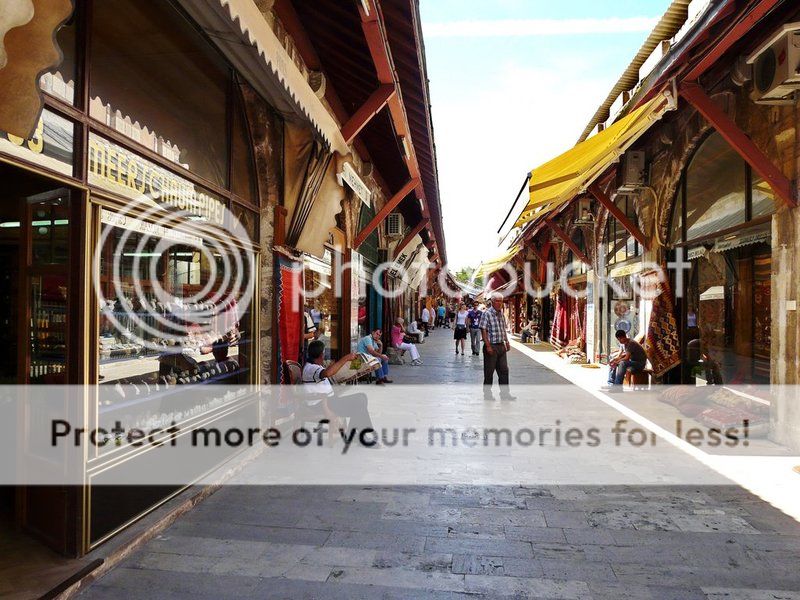GPS : 41°00'19.0"N 28°58'42.5"E / 41.005278, 28.978472

PHOTOGRAPHS ALBUM
"Arasta" is a bazaar where handcraft products are sold. The Arasta Bazaar is located directly behind the Blue Mosque, on the north side of Torun Street. There are more than eighty stores in the bazaar. It is also known as the “Sipahi Çarşısı” in Turkish because the needs of the Sipahi (the name of an Ottoman cavalry corps) were sold here during the Ottoman period. Tucked away next to the Blue Mosque in two short shop-lined pedestrian streets is the Arasta Bazaar - Sultanahmet's own miniature version of the Grand Bazaar.
Built at the same time as the Blue Mosque, this area originally served as a marketplace, with the rents from the shops going toward the upkeep of the mosque. During Ottoman times, it was known as the Sipahiler Bazaar, and specialized in items for the cavalry. Later it fell out of use and was used as a stable for horses. Ravaged by fires, the area was left in ruins and largely ignored for many years.
After a fire in 1912, the bazaar lay in ruins for a long time. Later, it was occupied by slum residents. The slums were laterremoved and shops were restored. Revamped in 1974, it now houses 83 shops, most specializing in carpets and textiles, but with the usual touristy kitsch thrown in for good measure to hopefully tempt some of the passing tourists to wander inside for a look. As you wander the streets, take a break from window-shopping and look at the walkway itself. The Bazaar was put into service by the General Directorate of Turkish Foundations in the 1980s.
For carpet and felt shopping, Arasta offers a much more laid-back atmosphere than many parts of the Grand Bazaar. During tourist season shopkeepers are out, as to be expected, trying to lure customers and offering endless glasses of tea, but there is not the persistent hassling found in many of the other parts of Sultanahmet. A large number of the customers who shop here are serious collectors who know what they are looking for and where to find it.
Here and there, you will see bits and pieces of mosaics and tiles poking up between the stones. These are some of the remnants from the Great Palace of Byzantium built by Constantine. Thought to have at one time extended from the Hagia Sophia and Hippodrome down to the coastline, the basic design was planned by the Emperor Constantine I.
The vast structure contained an assortment of state buildings, including numerous courtyards, throne rooms, audience rooms, churches, chapels, fountains, libraries, assembly halls, thermal baths and stadiums. Over the centuries, the complex fell victim to fires, earthquakes and neglect. The mosaics that remain from this mighty palace can be viewed at the Mosaic Museum, next door to the Arasta Bazaar. After winding around underground to view the impressive artwork, the exit deposits visitors once again at the heart of the bazaar.
The Arasta Bazaar was re-built on Byzantine ruins and is located on a narrow street with many lovely gift shops selling carpets, kilims, travel souvenirs, İznik tiles, scarves, etc on both sides of the street. The Arasta Bazaar complex was built at the same time as the Blue Mosque and functioned as a market area, the rents of which went towards the mosque's upkeep. It comprises 2 shop lined squares behind the Blue Mosque and a row of stable like shops stretching the length of the mosque's precinct.
The Arasta Bazaar in Istanbul is a small market close to the Sultan Ahmed Mosque. It is known for its jewelry, pottery, spice, textiles, and carpet shops. As opposed to the large crowds at the Grand Bazaar, the Arasta Bazaar is more low-key. Located at the Arasta Bazaar is the Great Palace Mosaic Museum.
LOCATION SATELLITE MAP
These scripts and photographs are registered under © Copyright 2016, respected writers and photographers from the internet. All Rights Reserved.
No comments:
Post a Comment